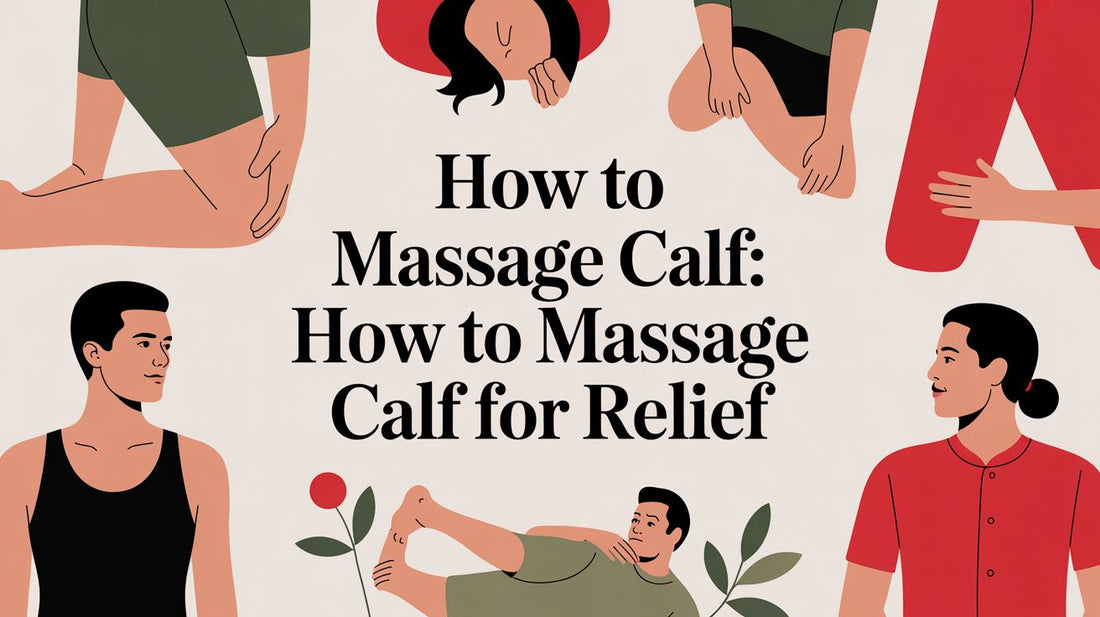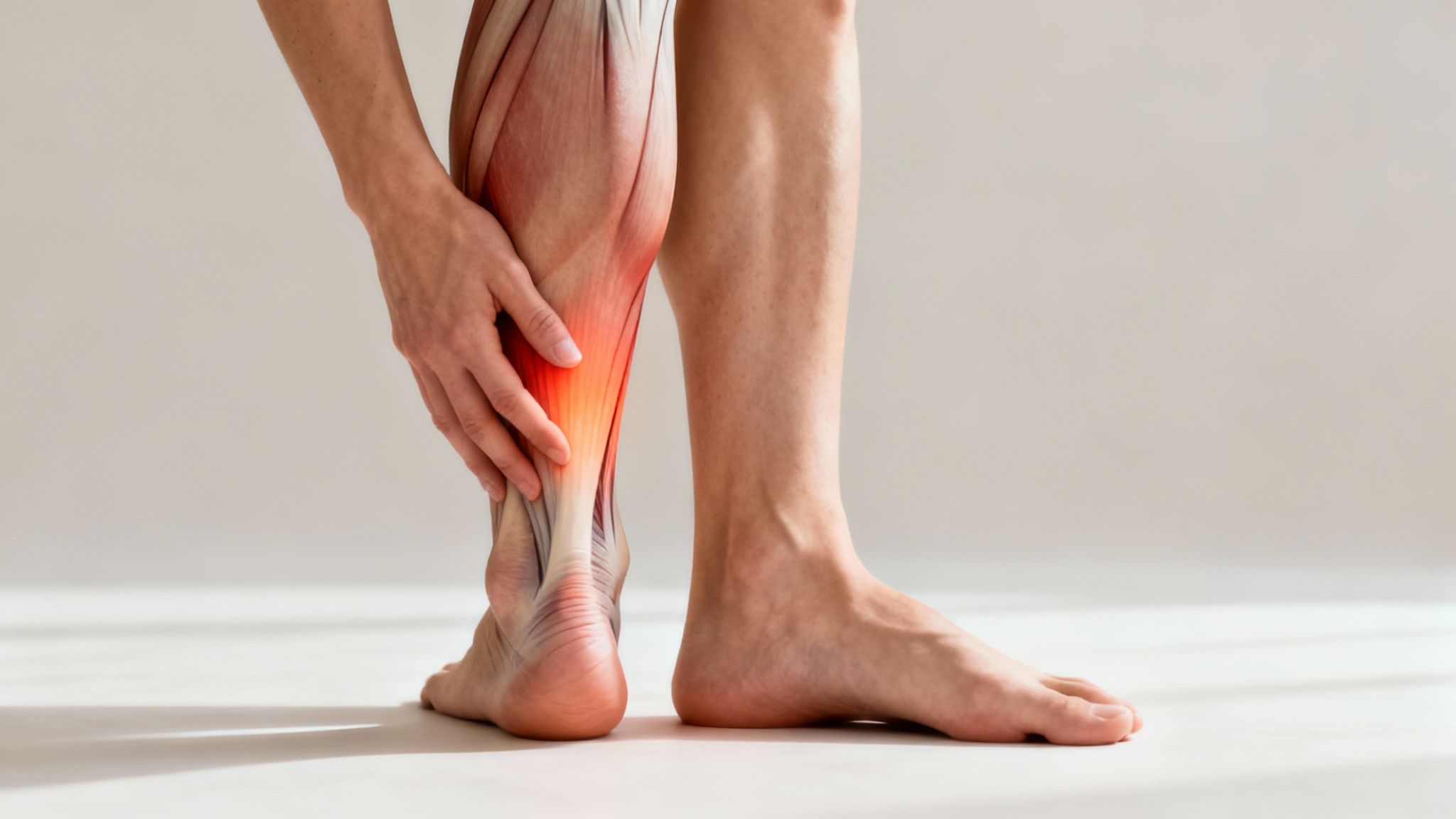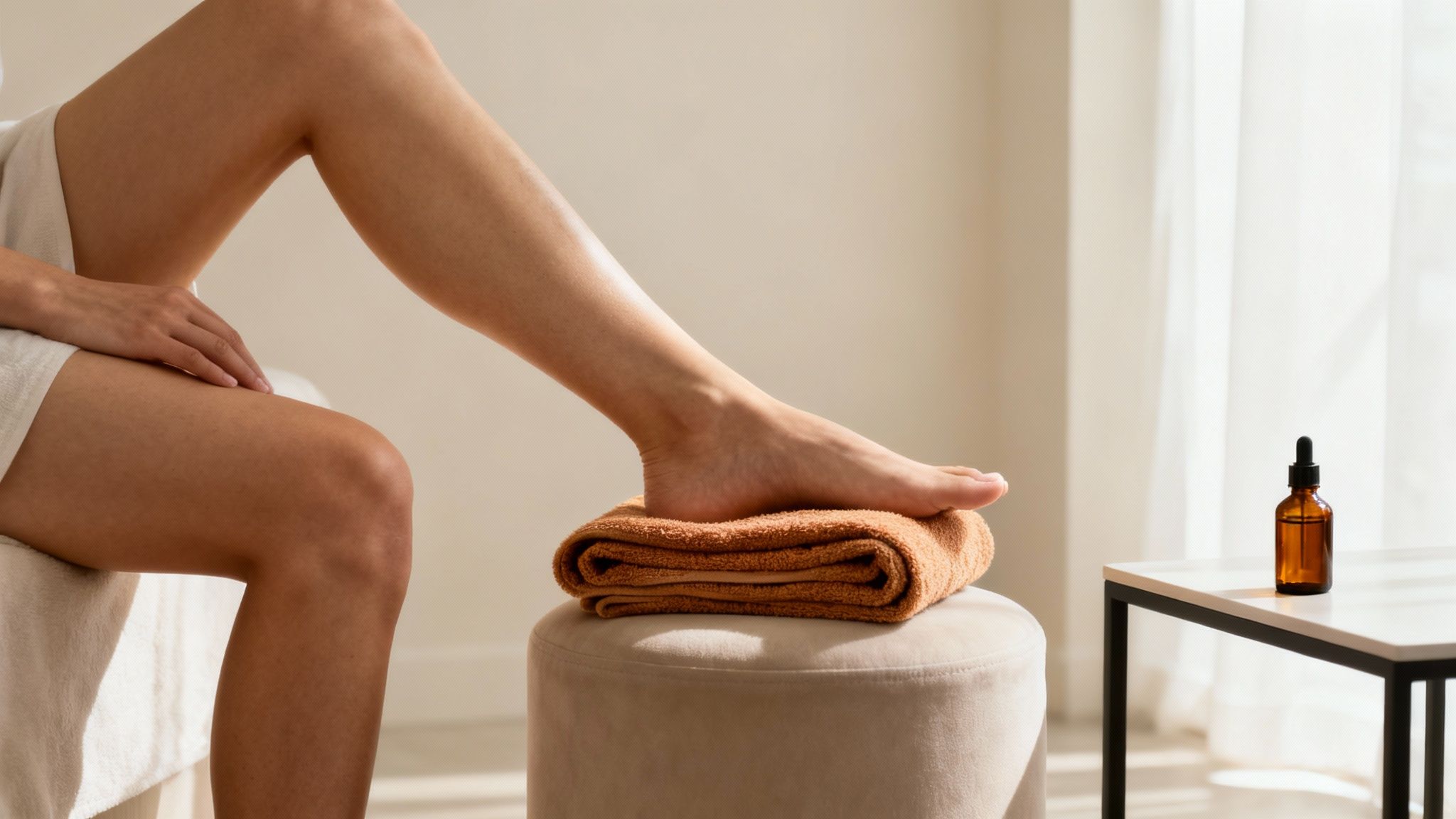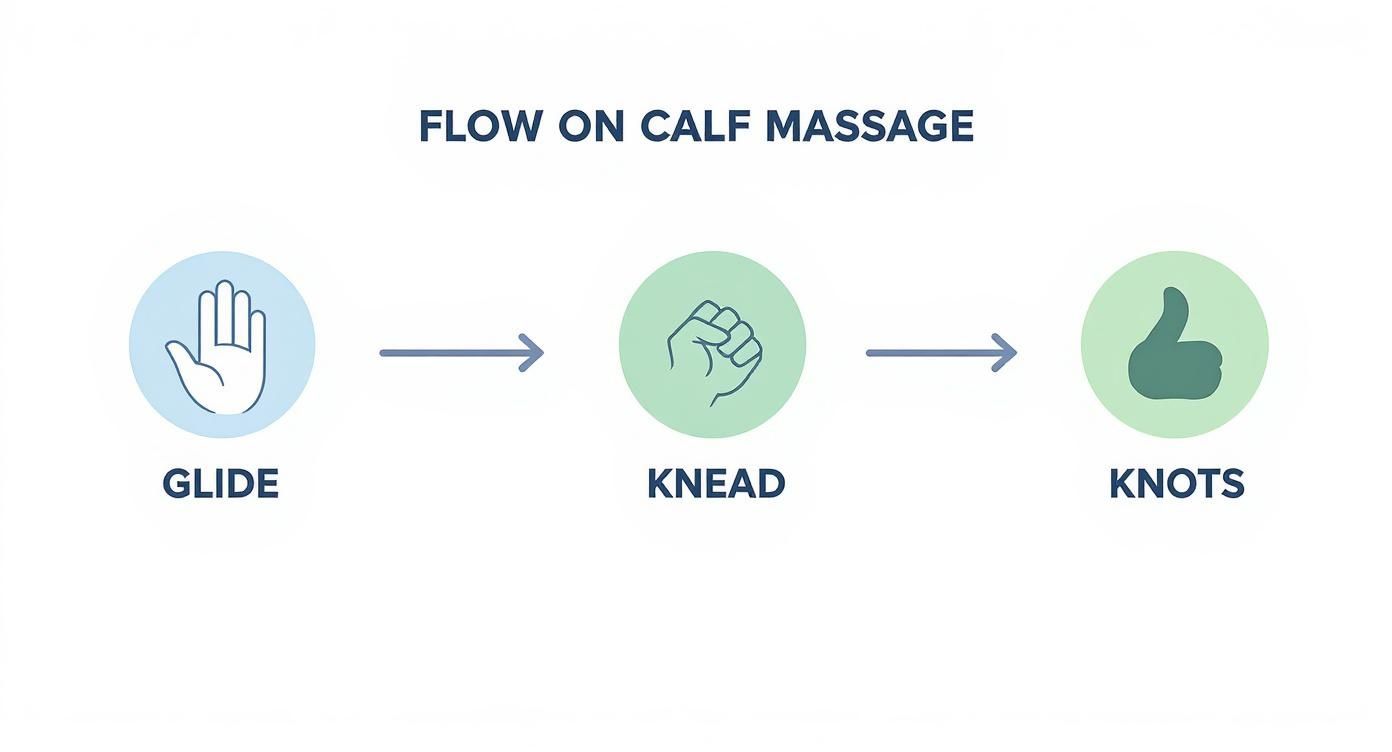
Learning how to massage calf muscles is a simple and effective way to manage daily aches and pains. Whether you're an athlete, an office professional, or just feeling the strain of a long day, your lower legs often bear the brunt of it. A targeted calf massage can help reduce that tightness and support better movement.
Why Your Calves Need Relief
Ever notice that deep, nagging ache in your lower legs after a busy day? You're not alone. Your calf muscles, the gastrocnemius and soleus, work hard to power you through walking, running, and even standing.
This constant use makes them prone to tightness and soreness. A tough workout, sitting for long hours, or even a long flight can leave your calves feeling stiff. Simple, everyday activities are often the biggest culprits behind discomfort.
"My calves used to be so tight after my runs in Central Park. A few minutes with a massage gun completely changed my recovery routine. It’s a total game-changer." - Jessica R., New York, NY

Understanding what causes this tension makes it easier to find relief. A few minutes of focused massage is a powerful self-care tool.
A consistent massage routine can:
- Support healthy circulation, bringing fresh blood to the area.
- Help reduce feelings of muscle tightness and stiffness.
- Promote a faster sense of recovery after physical activity.
This simple habit can make a huge difference in how your legs feel day-to-day. For more strategies, check out our guide on how to treat tight calf muscles.
Preparing for the Perfect Calf Massage
A great calf massage begins before you even start. A little preparation helps your muscles relax and get the full benefits of the session. Think of it like warming up before a workout—it makes everything more effective.
Taking a few moments to prepare your body and your space can turn a good massage into an amazing one.

First, find a comfortable position. Sit on the floor, a yoga mat, or a supportive chair where you can easily reach your calves without straining. The key is to let your calf muscle relax completely.
Prime Your Muscles for Relief
Warm muscles are more pliable and receptive to massage. A quick warm-up is always a good idea to get things started.
- Apply gentle heat. A warm towel wrapped around your calf for a few minutes can help boost circulation.
- Get moving. A few simple ankle rotations or flexing your feet back and forth will also help get the blood flowing.
- Add some glide. A small amount of massage oil or lotion allows your hands to move smoothly over the skin, preventing friction.
For an even better warm-up, use a tool like the Cryotex massage gun on its lowest setting. Gently float it over your calves for 30-60 seconds to help "wake up" the muscle tissue, preparing it for a deeper massage. Knowing the best time to use a massage gun can really level up your routine.
Giving Yourself a Great Calf Massage by Hand
You don’t need fancy equipment for an effective calf massage. Your hands are one of the best tools for providing relief, whether you're at your desk or cooling down after a workout. The key is to start gently and gradually increase the pressure.
First, get comfortable. Sit down and cross one leg over the opposite knee so you can easily reach your entire lower leg. Apply a little massage oil if you have some to help your hands glide smoothly.
Start with Long, Gentle Strokes
Before digging in, you need to warm up the muscle tissue. This technique, called effleurage, gets blood flowing and signals the muscle to relax.
Place your open palms on either side of your calf near your ankle. Using firm but gentle pressure, slide your hands up toward the back of your knee. Then, lighten the pressure and glide back down. Repeat this for a minute or two.
Move on to Kneading and Squeezing
Once the muscle feels warmer, you can move to a deeper technique known as petrissage, or kneading. This helps work out general tightness in the main belly of the calf.
Form a C-shape with your hand and wrap it around the meatiest part of your calf. Gently squeeze, lift the muscle slightly, and release. Work your way up and down the muscle in a slow, rhythmic motion for a couple of minutes.
"I used to get the worst calf cramps after long shifts on my feet. A friend from my yoga class showed me these simple hand massage techniques, and now I do them every night. It’s amazing how much of a difference it makes without needing any fancy tools." - Marcus T., Chicago, IL
Pinpoint Knots and Trigger Points
You may have found a few spots that feel extra tight. These "knots" require a more focused approach to help them release.
Use your thumbs or knuckles to apply direct, steady pressure to a knot. Press in firmly—it might feel intense, but it shouldn't be sharply painful. Hold the pressure for about 20-30 seconds while breathing deeply, and you should feel the muscle start to soften.
Just don’t overdo it. Focus on two or three of the tightest spots in a single session to avoid irritating the muscle. Listen to your body and back off if you feel any sharp pain. For more on maximizing your recovery tools, check out our massage gun attachment guide.
Taking Calf Recovery to the Next Level with a Massage Gun
While a hand massage is great, a massage gun can significantly enhance your recovery. Percussion massagers like our Cryotex model send rapid pulses deep into the muscle, which can help support circulation and reduce tightness more efficiently than hands alone.
Using one is simple. The key is to use the right technique and choose the correct attachment for the job.
For the large, fleshy parts of your calf, the standard ball attachment is ideal. Its wide surface is perfect for warming up the muscle and addressing general soreness. If you have a stubborn knot, switch to the bullet head for more targeted relief.
Your Go-To Massage Gun Technique
Always start on the lowest speed setting. You can increase the intensity as your muscles adapt, but remember that more power isn't always better. The goal is relief.
- Glide, Don’t Force It: Let the gun do the work. Float it over the main belly of your calf muscle in a slow, steady motion.
- Keep It Moving: Avoid holding the gun in one spot for too long. A constant, gentle movement is best.
- Stay in the Safe Zone: Stick to the soft tissue of your calf. Avoid bony areas like your shin and sensitive spots like the back of your knee.
A solid session only takes about 90 seconds to two minutes per calf. That’s all you need to get the benefits without causing irritation.
The infographic below offers a simple visual guide for an effective calf massage flow.

As you can see, the process moves from broad strokes to more targeted kneading to address extra-tight spots.
Choosing the Right Attachment
Picking the right massage gun head makes a huge difference. Each attachment is designed for a specific purpose.
"I run marathons, and the Cryotex ball attachment is my go-to for my calves. It gets deep enough to relieve tightness without being too intense. It's a non-negotiable part of my post-run routine." - David L., Los Angeles, CA
Here's a quick cheat sheet to help you choose the best attachment for your calves.
Choosing the Right Massage Gun Attachment for Your Calves
| Attachment Head | Best For | Pro Tip |
|---|---|---|
| Standard Ball | General, all-over calf massage and warm-ups. | Start every calf session with this one to get the blood flowing before you get more specific. |
| Bullet Head | Targeting deep, stubborn knots and trigger points. | Use this sparingly and only after the muscle is warmed up. Don't press hard; let the shape do the work. |
| Flat Head | Denser muscle tissue and flushing out lactic acid. | Great for a post-workout flush. Its solid surface covers a good amount of area with firm pressure. |
| Fork/Spine Head | Working the muscles that run alongside the shin bone (tibialis anterior). | Be very careful to avoid direct contact with the bone. This one is for experts! |
To get the full rundown on every attachment and how to use it, check out our complete massage gun attachment guide for more in-depth tips and tricks.
Common Calf Massage Mistakes to Avoid
Knowing the right techniques is important, but knowing what not to do is just as crucial for safe, effective relief.
Avoiding a few common mistakes can be the difference between feeling better and feeling worse. The biggest error is going too hard, too fast. Forcing a massage gun or elbow deep into a cold muscle can lead to bruising and soreness.
The Dangers of Massaging an Injury
This is critical: never massage an acute injury. If you’ve just pulled or strained your calf, you'll likely feel a sudden, sharp pain. Massaging a fresh injury can interfere with the body's natural healing process and potentially worsen the damage.
For new injuries, stick with the classic R.I.C.E. method:
- Rest: Stop any activity that causes pain.
- Ice: Apply a cold pack for 15-20 minutes at a time to help reduce swelling.
- Compression: A simple bandage can help manage inflammation.
- Elevation: Keep your leg propped up above heart level when possible.
Don't forget to breathe. Many people hold their breath when they hit a tender spot. Deep, steady breathing helps send oxygen to your muscles, encouraging them to release tension.
A Few Common Questions About Calf Massage
Even with the right technique, it's normal to have a few questions. Here are answers to some common concerns.
How Often Should I Be Massaging My Calves?
For general maintenance and soothing sore muscles, massaging your calves three to five times a week is a great starting point. If you're an athlete or on your feet all day, you might benefit from a quick, daily session to prevent tightness from building up. Consistency is key.
How Long Should a Calf Massage Last?
You don't need a lot of time to see results. For a focused self-massage, 2-3 minutes per calf is a perfect duration. If you’re using a percussion massager like the Cryotex, you can achieve great benefits in as little as 90 seconds per leg. The goal is to stimulate the muscle without overdoing it.
If your calf starts to feel irritated or overly sensitive, that’s your body's signal to stop for the day.
Is It Okay to Massage a Calf Cramp?
This is a tricky situation. For a sudden calf cramp (a "charley horse"), the best first step is usually a gentle, passive stretch. However, a very light massage with soft, gliding strokes can sometimes help the muscle relax.
Avoid any deep or aggressive pressure, as this can make the cramp worse. Once the cramp has passed, a more thorough massage the next day can help with any lingering soreness. To learn more about muscle care, check out our other helpful blog posts.
Ready to give your calves the pro-level relief they deserve? The BestMassageGun.com team is here to help you get started on your wellness journey.
Shop the Cryotex Holiday Bundle — 4 FREE Turkish Towels